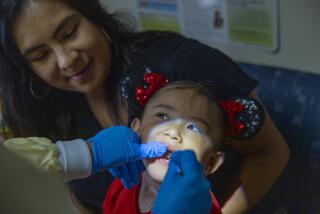FDA Says Jury’s Out on Home Tooth Whiteners : Personal health: People who want to brighten their smiles are asked to watch out for risks associated with bleaching kits. More isn’t always better, some dentists say.
- Share via
Smile. Or are those pearly whites just not bright enough to dazzle anybody?
Join the club.
In their endless quests for award-winning teeth, Americans have tried all sorts of home remedies--including Clorox, a complete no-no--to whiten them. Those who could afford it have badgered dentists for whitening preparations since before the turn of the century.
Dentists nationwide have obliged, using heat and hydrogen peroxide to bleach teeth, capping or bonding them.
But in the past three years, a new technique has surfaced--home teeth-whitening kits. Today, about 20 firms market them, and while most are sold over the counter, some are only available through dentists.
Home whiteners are effective, many dentists say, but there are drawbacks. They whiten normal teeth, but not caps or fillings.
“We call it the rainbow effect,” says Dr. Christine Dumas of Marina del Rey, who specializes in cosmetic dentistry and is a consumer adviser for the American Dental Assn. “You can get six different colors on your six front teeth.” But Dumas, her colleagues at the ADA and federal Food and Drug Administration officials say a more important question is whether home tooth whiteners are safe.
On that, the jury is still out.
“There’s nothing new about the materials being used, it’s how they’re being used,” says Phil Weintraub, an ADA spokesman. “We’re not saying this (home products) is the anti-Christ in tooth whitening form. We simply want to do what’s right and make sure these whiteners are safe. We can’t tell you they are right now.”
Although countless consumers have used the home kits--no one has accurate figures--increasing safety concerns prompted warning letters from the FDA last fall to 11 manufacturers. (Home whitening kits differ from the several brands of whitening toothpastes, which are termed cosmetics and have not been subjected to an FDA sanction.)
The letters advise that the whitening kits violate the federal Food, Drug and Cosmetic Act because FDA officials have ruled that they are drugs, not cosmetics, as previously designated. But the FDA did not order the firms to halt sales.
“Those products that are still out there are there illegally,” says FDA representative Sharon Snider. “They have to be approved as drugs and that’s a lengthy process through long-term clinical studies. It takes two or three years. We have warned the manufacturers that the products may be seized from the shelves.”
Classifying home whiteners as drugs forces manufacturers to provide scientific data “that they are safe and effective for their intended use,” according to the FDA letter.
Products deemed to be drugs must have FDA approval, while cosmetics are under less scrutiny. Cosmetics are required simply to be made of FDA-sanctioned “safe ingredients.”
The FDA and the 150,000-member ADA are concerned about the long-term effect home bleaching kits have on teeth and mouth tissue.
The bleaching kits usually feature a three-step process: an acidic rinse, a 10% carbamide peroxide gel applied to the teeth (which breaks down into a 3% hydrogen peroxide solution in contact with mouth fluids) and a polishing paste that applies pigment to teeth. Contained in most pastes is titanium dioxide, the same ingredient found in “white out,” the correction fluid.
In the fall of 1990, the ADA’s Council on Dental Therapeutics first expressed concerns about safety of the “oxygenating agent” in the products--hydrogen peroxide--and the acid treatments of the teeth.
The council cited a 1986 Harvard study that suggested oxygenating agents could damage mouth tissue, delay healing and harm the pulp inside teeth. Other numerous studies, the ADA said, “show that oxygenating agents such as hydrogen peroxide may cause irreversible cell changes and/or enhance the effect of carcinogens.”
It also warned that the products that include acid-cleaning solutions could damage enamel and the tissue under it, known as dentin.
More red flags flew last June after a negative article in the Chicago Dental Society Review.
Two Chicago-area dentists had examined a 13-year-old boy, who experienced 50% enamel loss and other tooth damage after using an over-the-counter whitening product with a three-step system. The boy had used the product once a day, five days a week, for two months.
“The profession should be immediately alerted to a potentially catastrophic problem,” the two dentists wrote. “In this case, we have a young teen-age patient who has non-reversible destruction to what was previously sound tooth structure.”
At issue is carbamide peroxide, used for many years by dentists to help heal mouth sores or as a rinse after dental surgery. But it has not been utilized for prolonged periods of time, as is the peroxide gel put in a night guard or painted on the teeth twice a day during a two-week (or longer) process at home.
Although the 11 manufacturers were given 15 days to notify the FDA “of the steps they have taken to comply with the law,” the FDA’s Snider says few have replied.
Epi Products of Santa Monica, Amazing White Labs of Denver and Den-Mat Corp. of Santa Maria sent data to the FDA, but Snider says the federal agency doesn’t think the information is clinically sound. Neither does the ADA.
Epi Products, manufacturers of EpiSmile, filed for Chapter 11 bankruptcy last August. (A Times reporter has been unable to reach the firm because its telephone had been disconnected and no new number has been listed.) EpiSmile, however, is still sold in stores.
Gary Schlatter, president of Amazing White, which has been on the market for about a year, says his firm is awaiting a response from the FDA: “It was certainly a surprise to have them change the status (to a drug). Carbamide peroxide has been used safely orally for 10 to 20 years.”
Dr. Robert Ibsen, a Santa Maria dentist who is president of Den-Mat, says his company has funded research at several universities on its Rembrandt whitening system, which contains peroxide but not acid. The studies show, he says, that the product whitens teeth but doesn’t compromise tooth structure.
Ibsen says the Rembrandt system is available only from dentists, not over-the-counter, because he believes the bleaching systems should not be dispensed without dental supervision. “It should be a service offered by a dentist, who examines the patients, and can tell them exactly what to expect and what not to expect,” he says.
“The tragedy is, the impression people get is why spend money with a dentist when you can go down to the drugstore and get the same thing. But you’re not buying the same thing for $30 that you’re buying from the dentist, who supervises it.”
The take-home treatment from a dentist is not cheap. It can cost from $300 to $1,000, depending on the dentist’s examination fees, cost for a mouth guard and how much time the whitening process takes.
All of which has prompted critics to claim that dentists simply don’t want to lose money because people can bleach their teeth at home.
In a press release, the recently-formed National Tooth Whitener Coalition, formed by CCA Industries of East Rutherford, N.J., insists that the ADA “has a vested interest in making it more difficult for consumers to obtain relatively inexpensive, over-the-counter teeth whiteners . . . and clearly wants consumers to have to go to a dentist for a very expensive teeth-whitening procedure.”
Interestingly, CCA Industries, which claims that its $10 Plus+White kit is the best-selling over-the-counter whitener in the nation, did not get an FDA warning letter. But a coalition spokesman says that CCA decided “to step forward because of the impact on its business” from inaccurate news coverage of the subject.
CCA and the Coalition, he says, agree with FDA and ADA concerns about whiteners containing more than 3% peroxide and those prescribed by dentists to be worn in a mouth guard.
The label on the CCA whitening kit cautions that the product “should not be used by children under the age of 16 . . . and is not recommended for people with gum disease, gingivitis, dental braces, severe receding gums or if allergic to any of the ingredients.”
Los Angeles dentist Dr. Joel Reims has used Peroxigel, an FDA-approved peroxide solution, to whiten patients’ teeth for about two years. He also uses it himself, putting one drop per tooth in a soft plastic night guard.
“You wear it two hours a day for two weeks, with monitoring, and it will change the color about two shades,” he says.
“But there are a few things to be careful of, overuse, or if you have any irritation around the gum tissue, go back to the dentist. All of this should be supervised by the dentist. In the wrong hands, it might do damage.”
Dumas, who has bleached patients’ teeth at her office for more than 15 years using peroxide, heat and a rubber protector for the gums, insists the safest, most effective way to go is still in-office bleaching by a dentist:
“And bleaching is not always the best option if there are any underlying problems (with the teeth and gums). One the biggest concerns of doing this at home is overuse, by people operating on the more is better theory.”






